Italian Mat Into
Page 60
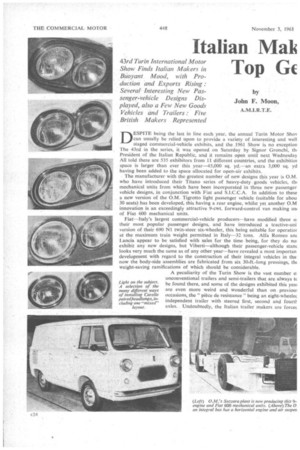
Page 61
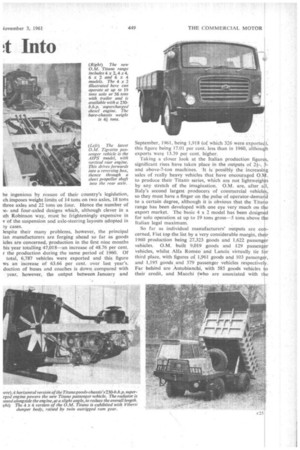
Page 62
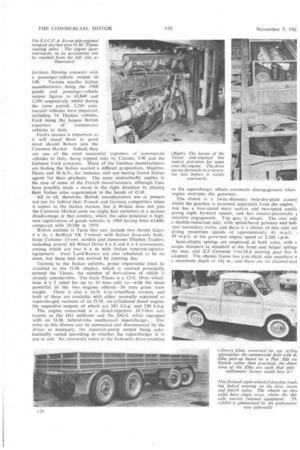
Page 63
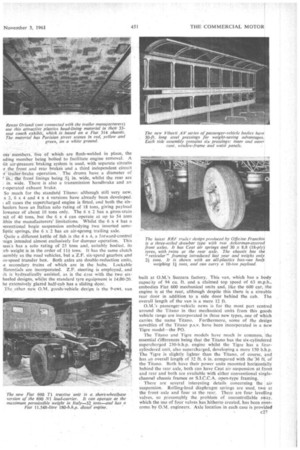
Page 64
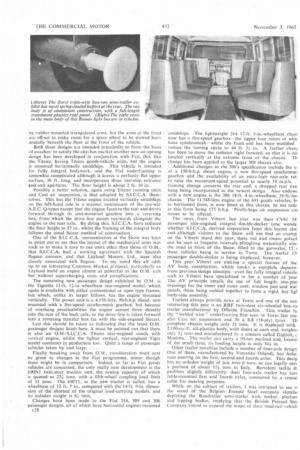
If you've noticed an error in this article please click here to report it so we can fix it.
43rd Turin International Motor
Show Finds Italian Makers in Top GC
Buoyant Mood, with Production and Exports Rising :
Several Interesting New Pasby senger-vehicle Designs DisJohn F. Moon,
played, also a Few New Goods Vehicles and Trailers : Five British Makers Represented
ESPITE being the last in line each year, the annual Turin Motor Shov can usually be relied upon to provide a variety of interesting and well staged commercial-vehicle exhibits, and the 1961 Show is no exception The 43rd in the series, it was opened on Saturday by Signor Gronchi, th President of the Italian Republic, and it remains open until next Wednesday All told there are 535 exhibitors from 11 different countries, and the exhibitioi space is larger than ever this year-45,000 sq. yd.—an extra 3,000 sq. yd having been added to the space allocated for open-air exhibits.
The manufacturer with the greatest number of new designs this year is G.M. who have introduced their Titano series of heavy-duty goods vehicles, thi mechanical units from which have been incorporated in three new passenger vehicle designs, in conjunction with Fiat and S.I.C.C.A. In addition to these a new version of the O.M. Tigrotto light passenger vehicle (suitable for abou 30 seats) has been developed, this having a rear engine, whilst yet another 0.M innovation is an exceedingly attractive 9-cwt, forward-control van making usi of Fiat 600 mechanical units.
Fiat—Italy's largest commercial-vehicle producers—have modified three ol their most popular passenger designs, and have introduced a tractive-uni version of their 690 NI twin-steer six-wheeler, this being suitable for operatiot at the maximum train weight permitted in Italy-32 tons. Alfa Romeo an( Lancia appear to be satisfied with sales for the time being, for they do no exhibit any new designs, but Viberti—although their passenger-vehicle start( looks very much the same as of any other-year—have revealed a most importan development with regard to the construction of their integral vehicles in tha' now the body-side assemblies are fabricated from six 30,ft.-long pressings, du weight-saving ramifications of which should be considerable.
LileA peculiarity of the Turin Show is the vast number o: unconventional trailers and semi-trailers that are always t( ght on the s oubject. be found there, and some of the designs exhibited this yea' A section f the many different ways are even more weird and wonderful than on previoth of installing Carello occasions, the "piece de resistance" being an eight-wheelec paired,headlamps,inindependent trailer with steered first, second and fount
eluding one "mixed"
layout. axles. Undoubtedly, the Italian trailer makers are force(
be ingenious by reason of their country's legislation, eh imposes weight limits of 14 tons on two axles, 18 tons three axles and 22 tons on four. Hence the number of and four-axled designs which, although clever in a tth Robinson way, must be frighteningly expensive in v of the suspension and axle-steering layouts adopted in iy cases.
/espite their many problems, however, the principal ian manufacturers are forging ahead so far as goods ides are concerned, production in the first nine months his year totalling 47,018—an increase of 48.76 per cent. r the production during the same period of 1960. Of total, 6,787 vehicles were exported and this figure ws an increase of 63.66 per cent, over last year's. duction of buses and coaches is down compared with year, however, the output between January and September, 1961, being 1,918 (of which 326 were exporte this figure being 17.01 per cent, less than in 1960, althou exports were 13.39 per cent. higher.
'raking a closer look at the Italian production figur significant rises have taken place in the outputs of 21-, and above-7-ton machines. it is possibly the increasi sales of really heavy vehicles that have encouraged 0. to produce their Titanb series, which are not lightweigh by any stretch of the imagination. O.M. are, after a Italy's second largest producers of commercial vehicl so they must have a finger on the pulse of operator-dema to a certain degree, although it is obvious that the Tita range has been developed with one eye very much on t export market. The basic 4 x 2 model has been design for solo operation at up to 19 tons gross--.5 tons above t Italian legal maximum.
So far as individual manufacturers' outputs are co cerned, Fiat top the list by a very considerable margin, th 1960 production being 27,323 goods and 1,622 passeng vehicles, 0.M. built 9,019 goods and 129 passeng vehicles, whilst Alfa Romeo and Lancia virtually tie f third place, with figures of 1,961 goods and 103 passeng and 1,195 goods and 379 passenger vehicles respective] Far behind are Autobianchi, with 585 goods vehicles their credit, and Macchi (who are associated with t
German. Bussing cOncern) with a passenger-vehicle output 61 148; Various smaller Italian manufacturers bring the 1960 goods and passenger-vehicle output figures to 43.840 and 2,396 respectively, whilst during the same period, 2,249 com mercial vehicles were imported, including 74 Thames vehicles.
Ford being the largest British exporters of' commercial vehicles to Italy.
Ford's success is important as it will stand them in good stead should Britain join the Common Market. Indeed, they are one of the most successful exporters of commercial vehicles to Italy, being topped only by Citroen, VW and the German Ford .company. Many of•the German manufacturers are finding the Italian market a difficult proposition, MagirusDeutz and MAN., for instance, still not having found Italian agents for their products. The same undoubtedly applies in the case of some of the French manufacturers, although Upic have possibly made a move in the right direction by placing their Italian sales •organization in the hands of O.M.
All in 'all, therefore, British manufactirers are at present not too far behind their French and German competitors when it comes to the Italian market, but if 'Brifain does not join the Common Market soon we might find ourselves at a serious disadvantage in that country, where the sales potential is high, new registrations of goods vehicles in 1960 having been 43,840, compared with 29,580 in 1959. .
British exhibits in Turin this year include two Austin Gipsy 4 x 4s. a Bedford TK 7-tonner with Italian drop-side body, three Commer 15-cwt. models and numerous Thames Traders, including several All Wheel Drive 4 x 4 and 6 x 4 conversions, among which are two 4 x 4s with Italian concrete-agitator equipment. Four Land-Rovers are also scheduled to be on show, but these had not arrived by opening day.
Turning to the Italian exhibits, primeimportance must be attached to the O.M. display, which is centred principally around the Titano, the number of derivations of which is already considerable. The basic Titano is a 12-ft. 10-in.-wheelbase 4 x 2 rated for up to 19 tons solo or—with the more powerful of the two engines offerec1-56 tons gross train weight. There is also a 16-ft. 6-in.-wheelbase version, and both of these are available with either normally aspirated m supercharged versions of an O.M. six-cylinderecl diesel engine, the respective outputs of which are 185 b.h.p. and 230 b.h.p.
The engine concerned is a direct-injection 10.3-litre unit known as the DO unblown and the DG-L when equipped with an 0.M. helical-lobe mechanical supercharger. The drive to this blower can be connected and disconnected by the driver as necessary, the injection-pump output being automatically varied according to whether the supercharger is in use or not. An automatic valve in the hydraulic drive-coupling
to the supercharger effects automatic disengagement when engine overruns the governor.
The clutch is a 14-in.-diameter twin-dry-plate assemt whilst the gearbox is mounted separately from the engine, ' box has a four-speed main section and two-speed auxili giving eight forward speeds, and has electro-pneumatic j selective engagement. Top gear is direct. The rear axis a double-reduction unit, with spiral-bevel primary and heli. spur secondary trains, and there is a choice of two axle rat giving maximum speeds of approximately 41 m.p.h. ; 49 m.p.h. at the governed engine speed of 2,200 r.p.m.
Semi-elliptic springs are employed at both axles, with t scopic dampers as standard at the front and helper spring the rear, and Z.F.-Gemmer 1-to-28.4 steering gear has b adopted, The chassis frame has i-in.-thick side members a maximum depth of 10+ in., and there are six channel-sect oss. members, -five Of which are flush-welded in place, the ad log member being bolted to facilitate engine removal. A pa air-pressure braking system is used, with separate circuits the front and rear brakes and a third independent circuit r trailer-brake operation. The drums have a diameter of the front linings being 54 in. wide, whilst the rear are :in. wide. There is also a transmission handbrake and an r-operated exhaust brake.
So much for the standard Titano: although still very new, x 2, 6 x 4 and 4 x 4 versions have already been developed. all cases the supercharged engine is fitted, and both the sixheelers have an Italian solo rating of 18 tons, giving payload lowance of about 10 tons only. The 6 x 2 has a gross-train nit of 40 tons, but the 6 x 4 can operate at up to 54 tonS ithin the manufacturers' limitations. Whilst the 6 x 4 has a mveritionat bogie suspension embodying two inverted semiliptic springs, the 6 x 2 has an air-sprung trailing axle. Quite a different kettle of fish is the 4 x 4, a forward-control sign intended almost exclusively for dumper operation. This lass's has a solo rating of 25 tons and, suitably bodied, its ;rb weight is in the order of 114 tons. It has the same clutch isembly as the road vehicles, but a Z.F. six-speed gearbox and to-speed transfer box. Both axles are double-reduction units, Le secondary trains of which are in the hubs. Lockable fferentials are incorporated. Z.F. steering is employed, and is is hydraulically assisted, as is the ease with the two sixheeled designs, whilst the standard tyre equipment is 14.00-20.
he extensively glazed half-cab has a sliding door. • The ,other new 0.M. goods-vehicle design is the 9-cwt. van built at 0.M.'s Suzzara factory. This van, which has a body capac;ty of 94 cu. ft and a claimed top speed of 63 m.p.h., embodies Fiat 600 mechanical units and, like the 600 car, the engine is at the rear, although despite this there is a sizeable rear door in addition to a side door behind the cab. The overall length of the van is a mere 12 ft.
0.34.'s passenger-vehicle news is for the most part centred around the Titano in that mechanical units from this goods vehicle range are incorporated in three new types, one of which carries the name Titano. Furthermore, some of the design novelties of the Titano p.s,v. have been incorporated in a new Tigre model—the PO.
The Titano and Tigre models have much in common, the essential eifferences being that the Titano has the six-cylindered supercharged 230-b.h.p, engine whilst the Tigre has a fourcylindeled unit, also supercharged, developing a mere 150 b.h.p. The T!gre is slightly lighter than the Titano. of course, and has an overall length of 32 ft. 6 in, compared with the-36 ft. of the Titano. Both have their power units mounted horizontally behind the rear axle, both can have Ceat air suspension it front and rear and both are available with either conventional singlechannel chassis frames or S.I.C.C.A. open4ype framing.
There are several interesting details concerning the air suspension. Rolling-load diaphragm springs are used, two at the front axle and four at the rear. There are four levelling valves, so presumably the problem of uncontrollable sway, which the use of four valves has,hitherto created, has been overcome by O.M. engineers. Axle location in each case is provided by rubber-mounted triangulated arms, but the arms at the front are off-set to make room for a spare wheel to be stowed horizontally beneath the floor at the front of the vehicle.
Both these designs are intended principally to form the basis of coaches: to satisfy the city-bus market another new air-sprung design has been developed in conjunction with Fiat, this, like the Titano, having Titano goods-vehicle units, but the engine is mounted horizontally amidships. This vehicle is intended, for fully integral bodywork, and the Fiat underframing is somewhat complicated although it leaves a perfectly flat upper surface, 36 ft. long, and incorporates three two-step entrance and exit apertures. The floor height is about 2 ft. 10 in.
Possibly a better solution, again using Titano running units and Ceat air suspension, is that adopted by S.I.C.C.A. themselves. This has the Titano engine located vertically amidships on the left-hand side in a manner reminiscent of the pre-war A.E.C. Q-types except that the engine faces to the rear and drives forward through its unit-mounted gearbox into a reversing box, from which the drive line passes rearwards alongside the engine to the rear axle. By doing this, S.I.C.C.A. have reduced the floor height to 27 in., whilst the framing of the integral body follows the usual Siccar method of construction.
One of the S.I.C.C.A. representatives at the Show was keen to point out to me that the layout of the mechanical units was such as to make it easy to use units other than those of 0.M., that S.I.C.C.A. had a working agreement with the Spanish Pegaso concern, and that Leyland Motors, Ltd., were also closely associated with Pegaso. To, my mind' this all adds up to an interesting Common Market prospect, particularly as Leyland build an engine almost as powerful as the O.M. unit but without supercharging costs and complications.
The remaining new passenger design exhibited by O.M. is the Tigrotto 11-ft. 11-in.-wheelbase rear-engined model, which again is available with either conventional or open type frames. but which, unlike its larger fellows, has the engine mounted vertically. The power unit is a 4.156-litre, 90-b.h.p. diesel, unit mounted with a five-speed synchromesh gearbox, but because of overhang practicabilities the engine cannot drive directly into the rear of the back axle, so the drive line is taken forward into a reversing transfer box (as with the side-engined Siccar).
Lest this should be taken as indicating that the latest O.M. passenger designs finish here, it must be pointed out that there is also an 0.M.-S.I.C.C.A. Titano rear-engined coach with vertical engine, whilst the lighter vertical, rear-engined Tigre model continues in production too. Quite a range of passenger vehicles taken by and large. . .
Finally breaking away from 0.M.. consideration must next be given to changes in the Fiat programme, minor though these might be in comparison. indeed. so far as Fiat goods vehicles are concerned, the only really new development is the 690N1 twin-steer tractive unit, the towing capacity of which is quoted. as 251 tons, with a fifth-wheel coupling load limit of 11 tons. The 690T1, as the new tractor is called, has a wheelbase of 12 ft. 7 in., compared with the 14-ft. 9-in, dimension of .the shortest of the original load-carrying models. and its unladen weight is 61 tons.
Changes have been made to the Fiat 314,. 309 and 306 passenger designs, all of which have horizontal engines mounted c28 amidships. The lightweight 314 12-ft. 3-in.-wheelbase chast now has a five-speed gearbox—the upper four ratios of whic have synchromesh—whilst the front end has been modified reduce the turning circle to 44 ft. 3. in. A further charn has been to move the radiator right forward, so that it is no located vertically at the extreme front of the chassis. Th change has been applied to the larger 309 chassis also.
Additional changes to the 309's specification include the 1.1. of a 150-b,h.p. diesel engine, a new five-speed synchrome: gearbox and the availability of an extra-high rear-axle rat to raise the maximum-speed potential to nearly 55 m.p.h. framing change concerns the rear end, a dropped rear ove hang being incorporated in the newest design. Also endow( with a new engine is the 306 18-ft. 4-in.-wheelbase, 36-ft.-lor chassis. The 11.548-litre engine of the 691 goods vehicles, In in horizontal form, is now fitted to this chassis, its net ratir in this form being 175 b.h.p. Pirelli-Saga air suspension cm tinues to be offered.
The news from Viberti last year was their CV61 14 passenger side-engined integral double-decker (one wonde whether S.I.C.C.A. derived inspiration from this layout alsc and although visitors to the Show will not find an examp on the Viberti stand this year, these red and cream goliatl can be seen at frequent intervals ploughing majestically alor the road in 'front of the Show, filled to the gunwales, 12 ( these vehicles being in service in Turin. The Aerfer 151 passenger double-decker is Ibeing displayed, however.
This year Viberti are making a special feature of the AV body construction, which marks a complete departui from previous design concepts—even for fully integral vehicle such as Viberti have specialized in for a number of 'year The AV principle entails the use of full length, one-pies pressings for the inner and outer cant, window pan and vvai panels, these being welded together to form a rigid, but ligl body-side assembly.
Trailers always provide news at Turin and one of the mo interesting this year is an RRF twin-steer six-wheeled box-va trailer manufactured by Officine Franchin. This trailer In the "welded wire" underfrarning first seen in Turin last yea also Ceat air suspension and 30 x 8.8 (18-ply) tyres. Th complete chassis weighs only 21 tons. It is displayed with 2,100-cu.-ft. all-plastics body, with doors at each end, weighin only 11 tons and manufactured by a concern called Giglioli, c Modena. The trailer can carry a 10-ton payload and, becatu of the small tyres, its loading height is only 341 in.
Other trailer novelties include a number of four-axle design One of these, manufactured by Vincenzo Orlandi, has Acke. man steering on the first, second and fourth axles. This desig has an unladen weight of just over 6 tons, so can legally care a payload of about 15+ tons in Italy. 13artoletti tackle th problem slightly differently: their four-axle trailer has tun table-mounted first and fourth axles, connected by a crosse cable for steering purposes.
While on the subject of trailers, I was intrigued to see o the stand of the Belgian Pressed Steel company sketch( depicting the Roadrailer semi-trailer with tanker, platfort and tipping bodies, implying that the British Pressed Stei Company intend to expand the scope of their road-rail vehicli
























































































































